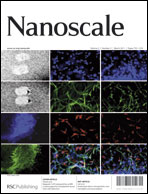Aqueous synthesis of ZnTe/dendrimer nanocomposites and their antimicrobial activity: implications in therapeutics†
Abstract
The present strategy proposes a simple and single step aqueous route for synthesizing stable, fluorescent ZnTe/dendrimer nanocomposites with varying dendrimer terminal groups. In these hybrid materials, the fluorescence of the semiconductor combines with the biomimetic properties of the dendrimer making them suitable for various biomedical applications. The ZnTe nanocomposites thus obtained demonstrate bactericidal activity against enteropathogenic bacteria without having toxic effects on the human erythrocytes. The average size of the ZnTe


 Please wait while we load your content...
Please wait while we load your content...